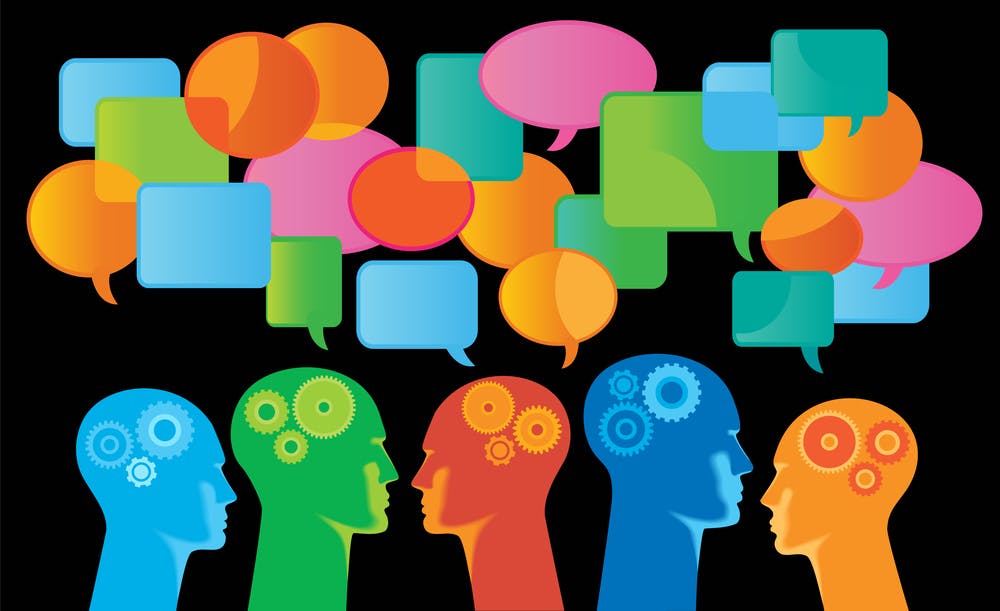Why does one person see a glass as half full and another sees it as half empty?
The difference is more than attitude. We unconsciously experience things differently in our minds, often completely unaware of anything other than something feeling comfortable – or not – for us.
Our brains use pattern recognition to manage and make sense of the enormous amounts of data they must process each day to keep us functioning at optimal levels. Understanding this process helps us better predict how others will act, persuade or communicate more effectively with them, and explains why they view the glass as half full or half empty.
Neurolinguistics
Neurolinguistics is the study of how the brain understands and produces language, so it drives how we communicate with ourselves and how we process verbal input.
Becoming acutely aware of the actual words we and others use opens us up to the inner workings of the brain and helps us to leverage those natural processes to become more empathetic and far better communicators. To lead our colleagues and help our friends, we must understand each individual and customize our language and approach for them.
Everyone has predominate patterns that drive how they communicate and respond to situations, so let’s take a look at the eight pattern filters and what they reveal to us about how to more effectively communicate with others.
1. Direction: Towards or away from
Each of us is motivated to gain pleasure and avoid pain or loss. But one of those is our primary mode. As leaders and coaches we need to understand our own filters and the filters of those we lead. To discover your own, or someone else’s primary mode, ask a question similar to “What’s important to you about work?” and pay close attention to the words used to answer. Those who prefer moving toward opportunities will talk about goals and what they want to achieve. Those who prefer to move away from will discuss avoiding risks or conflict; being cautious and safe.
2. Reason: Possibility or necessity
This pattern filter helps us understand why people take action. If asked “Why did you choose your last project?” those who act on possibility will talk about the opportunity, choice or variety of the project. Those who primarily act out of necessity will refer to the step-by-step process of making their decision, the reason they must do it, and the importance of finding the exact solution before taking action.
3. Frame of reference: Internal or external
Frame of reference explains how we judge our own actions – do we reflect internally for that evaluation, or do we seek feedback externally? Those with an internal focus will require less feedback and recognition from you than those who are externally oriented. They may not even take feedback well. You’ll gain their respect if, when asked a question, you inquire, “What do you think you should do?” The externally focused need others’ validation and can be more easily persuaded to another viewpoint.
4. Convincer: Five senses and frequency
The convincer pattern demonstrates what a person must experience to become convinced of something. If you ask, “How do you know when a person is talented?” they will tell which of their senses must be triggered (“I need to see it, hear about it or be shown it”) and the frequency of that demonstration (once, 2-3 times, or always). Use this data to frame your conversations with individuals and your persuasion skills will be enhanced.
5. Relationship: Sameness or difference
The relationship filter helps us understand how relationships are built. Determining if a person primarily sorts by looking for similarities or differences can be achieved by asking them to describe the relationship of items, like coins. Do they highlight the similarities or the differences of the coins? Difference people don’t build rapport well and may have a problem with routines, relationships or job stability. And don’t tell them what to do – they’ll innately want to do the opposite. When teaching, show difference people all the exceptions first; help sameness people find productive routines.
6. Attention: Self or others
Attention focuses on how people show other people they’re paying attention. It’s a very subtle pattern that must be observed. Self-sorters are all about themselves – they give little attention to what someone is saying until it directly concerns or interests them. Those who sort by others pay attention with eye contact and provide feedback when others are speaking. This is an important quality in service industries and group interactions, but in the extreme, self-sorters can appear selfish, and those who sort by others can come off like martyrs.
7. Focus: General or specific
When we have a general focus, we’re big picture, high-level overview, forest-for-trees thinkers. We often speak in generalities and are quick to summarize ideas or points. As expected, those whose primary focus is specific are motivated by details and sequences. They want precision and exactness, and are trees-for-forest thinkers. When asked, “How do you solve problems?” do your colleagues answer with specifics or a summary?
8. Action: Active or reflective
The Reason pattern (#2) helped us understand why people take action; this pattern helps us understand how and when people take action. Active sorters want to charge ahead immediately and get things done. Those who sort reflectively like to analyze, consider multiple options, and wait until they fully understand a situation before acting. Responses to, “How do you learn new things?” will reveal peoples’ dominate pattern if we listen carefully to their word choices.
A version of this appeared previously on OCTanner.com.
